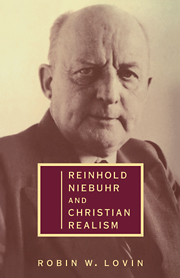An introduction to Christian Realism
Published online by Cambridge University Press: 22 August 2009
Summary
During the first half of the twentieth century, Protestant theologians in the United States gave new attention to the social forces that shape and limit human possibilities. Like the leaders of the Social Gospel movement before them, these writers were concerned with the gap between the biblical vision of God's rule and the realities of modern industrial society. For the new generation, however, a Christian conscience informed by scientific study would not suffice to close the gap. The biblical ideal stands in judgment not only on the social reality, but also on every attempt to formulate the ideal itself.
Therefore, social achievements provide no final goal. The dynamics of history are driven by the human capacity always to imagine life beyond existing limitations. Biblical faith gives vision and direction to that capacity for self-transcendence, but we are best able to challenge and channel our powers when we also understand what is really going on.
‘Christian Realism’ is the name that has been given to that way of thinking. It is a term closely associated with Reinhold Niebuhr, when it is not exclusively identified with his thought. It is, however, important to remember that the theological movement originated before Niebuhr took it up as his own. From the early 1930s, D.C. Macintosh and Walter Marshall Horton wrote about “religious realism” or “realistic theology” in ways that influenced Niebuhr's call for a church that would produce “religious or Christian realists.” The term ‘Christian Realism’ belongs perhaps as much to John C. Bennett as to Niebuhr, and certainly others both in Christian ethics and in political philosophy have adopted the idea and developed it in their own ways.
- Type
- Chapter
- Information
- Reinhold Niebuhr and Christian Realism , pp. 1 - 32Publisher: Cambridge University PressPrint publication year: 1995



